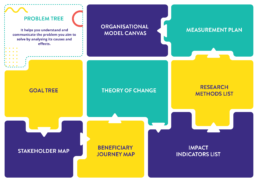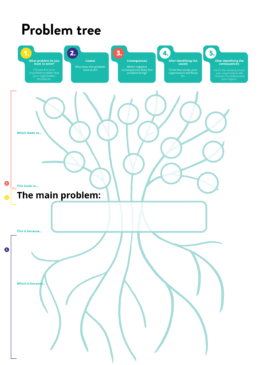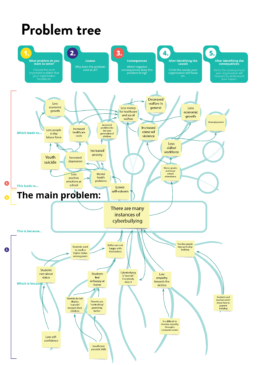Problem Tree
A PROBLEM TREE helps you understand and communicate the problem you aim to solve by analysing its causes and effects.
Solveiga Skaisgirytė (Global Citizens Academy)
For us, the most useful way is to use the problem tree for our team problem analysis so that we can understand the sources of communication, productiveness problems, why we face the recurring conflicts, etc.
But we also find it very useful when analysing the general problems in our community/society that we seek to solve as a social enterprise.
Jānis Broks (SIA “Dzīves oāze”)
The problem tree allows me to better show the situation that will be achieved in the future after my service is done.
It allows me to dig deeper and see several layers of what can happen with/without my intervention. It helps me to justify the price of the service as the tree shows what kind of effect/impact my activities can have.
What is it?
Organisations exist to solve one or multiple problems in the community or society. The problem tree helps you to systematically analyse the causes and effects of the problem(s) that you want to solve as a part of your organisation’s mission.
The easy-to-use tool works best during the design and/or planning process, but also anytime when core problems need to be (re)identified or clarified.
Perhaps you are one of those people who do not like the word “problem”. In that case, feel free to rename it as a tree of challenges, needs or issues. The tool will remain as useful for you as before.
This tool helps you understand a) why the problem exists at all and b) what things happen as a result of the problem. Mapping the causes of the problem may help you understand what you need to do to make the problem disappear. Mapping the consequences of the problem can help you understand what would the positive results be if the problem would be lessened or removed.
First, you have to define the core problem that your mission focuses on.
Below the core problem, write the main causes of the problem and the causes of the main causes etc. until you understand the causes well enough.
Above the core problem, write the main consequences of the problem and the consequences of the main consequences etc. until you understand the consequences well enough.
Watch the video to get an idea of what the tool is about or continue reading after the video player.
In more detail…
1.Start by writing down the core problem that you want to solve.
2.Write down the causes of the problem by asking a series of “why” questions. The deeper you go, the better.
The core problem is P.
Why does P exist?
Answer = A.
And why does A exist?
Answer = B.
And why does B exist?
Answer = C
Etc.
3.Write down the consequences. What does the problem lead to?
The core problem is P.
What does P lead to?
Answer = R.
And what does R lead to?
Answer = S.
Etc.
4.Analyse the problem tree and make choices about your mission and activities.
- Would you like to keep a problem as the central problem you’re focusing on, or would it be more inspiring/realistic to tackle any of the causes/consequences as your main mission?
- What causes/consequences can you tackle yourself? What would be the partnerships that you would need to remove more causes or consequences of the problem?
You can also have variations in its use
Variations in certainty.
LIGHT: Write down the keywords based on your (team’s) experience, opinions and gut instinct.
MEDIUM: Involve other organisations, ask for expert opinions, including the viewpoints of the stakeholders that have different experiences and values compared with your team.
ADVANCED: Only include causes and consequences that the scientific research and literature has shown to have clear links to the main problem.
Why to use it?
☑ To understand better the problem(s) your mission aims to solve (or to find out what your mission should be).
☑ To make informed decisions about which aspects of the problem you can and want to concentrate on.
☑ To better explain and communicate the problem and its causes/effects to the stakeholders whom you need to convince. You can show the tree or just use it to prepare your arguments for presentations or negotiations.
When to use it?
☑ When developing or updating your mission and vision or specifying your strategic choices.
☑ When the organisation aims to understand and communicate certain topics/problems better.
☑ When you want to change or expand your activities to tackle more causes.
☑ When looking for cooperation partners (to collaborate with organisations that address the causes and/or consequences of the problem that you cannot or don’t want to address with your own organisation).

Achievements
Since the foundation in the autumn of 2015, the Social Entrepreneurship Association of Latvia has become one of the leading organizations in the social entrepreneurship sector in Latvia, not only taking care of improving the capacity, knowledge, and skills of its members in various ways but also developing and promoting the overall social enterprise ecosystem in Latvia.
The most important accomplishments of the Association, which have significantly contributed to the development of the social entrepreneurship sector in Latvia:
- As a result of the three years of work and active involvement of the Association, the Latvian parliament Saeima unanimously adopted the Law on Social Entrepreneurship at the end of 2017, which came into force on 1 April 2018. The law, for the first time in Latvia, defines a social enterprise and the legal framework for its activities.
- The participation of the representative of the Association in the Commission on the Status of the Social Enterprise of the Ministry of Welfare provides a professional and experienced expert opinion during the status award process.
- Active participation in the development of a financial support program for social entrepreneurship of the Ministry of Welfare and ALTUM, ensuring the representation of the interests and needs of social enterprises, as well as a clear explanation of the possibilities and conditions provided by the program.
- Local governments in Latvia are aware of social entrepreneurship and its opportunities; more than 20 municipalities have been involved in activities to promote social entrepreneurship in their territories, together with British Council Latvia we have created a useful toolbox for municipality representatives and tested support mechanisms for social enterprises in 3 municipalities - Ogre, Rēzekne and Līvāni
- Business incubators and the employees of Investment and Development Agency of Latvia are informed and educated about social entrepreneurship, its nature and possibilities, as a result, the business incubators are open to social enterprises and are able to offer them appropriate support.
- Through active work, meetings and communication with other public and private actors, social entrepreneurship has become a topical and stimulating issue for various state and local government institutions (e.g., the State Employment Agency, International Youth Program Agency, etc.), banks, private investors, companies, etc.
- The topic of social entrepreneurship and social enterprise stories have been promoted in the media, including the biggest online press releases of Latvia (Diena, NRA, Latvijas avīze), on television (LTV, LNT, TV3), radio (LR1, LR5, LR6, Star FM), online portals (lsm.lv, DELFI, TVNET) and others.
- The Social Entrepreneurship Forum of the Association has become the most important annual event of the social entrepreneurship sector, bringing together more than 160 participants, lecturers and experts from Latvia and abroad. Resultant to the forum, a new audience was introduced with the topic of social entrepreneurship and valuable long-term relationships established.
- Every year the Social Entrepreneurship Catalogue of Latvia is published, introducing the Latvian and international audience with the success stories of Latvian social entrepreneurs.
- A network of Social Entrepreneurship Ambassadors has been established together with British Council Latvia, with more than 20 active creative community leaders in all regions of Latvia. Through the network of ambassadors, more than 3,600 people across the country have been informed about social entrepreneurship.
- Three international publications on various social entrepreneurship topics have been published, which are available free of charge at www.socialauznemejdarbiba.lv and have been proactively introduced to decision-makers and opinion leaders throughout Latvia.
- Through the ‘one-stop-shop’ consultations, more than 50 people have acquired the necessary knowledge, skills and information to implement their social entrepreneurship ideas.
- More than 100 educational and informative events throughout Latvia have been implemented, providing accessible and comprehensible information on social entrepreneurship opportunities in all regions of Latvia.
- Creation and maintenance of the largest and most comprehensive internet resource in Latvian on social entrepreneurship www.socialauznemejdarbiba.lv.
- Every year the Social Entrepreneurship Market is organized in cooperation with the Kalnciems Quarter - this event not only provides for the visibility of social enterprises but also informs the new audiences about social entrepreneurship.
- Together with the Association members and partners, especially the British Council of Latvia, we create a community to exchange social entrepreneurship knowledge and experience, as a result, new and productive cooperation and opportunities are available for Latvian social enterprises.
Do you want to join our work and engage in creating a social entrepreneurship environment while also using the diverse opportunities and privileges offered by the Association? Become a member! More information here.














